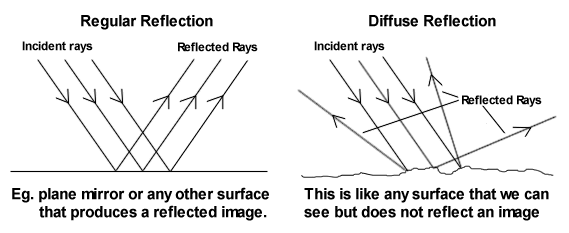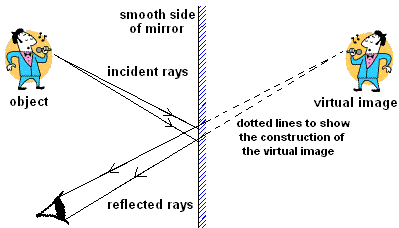NCERT Solutions for Class 8th Science Chapter 12 Light Textual Questions and Answers based on the latest syllabus of CBSE and JKBOSE NCERT Books
Light
Exercises
1. Suppose you are in a dark room. Can you see objects in the room? Can you see objects outside the room? Explain.
- In a dark room, you cannot see objects as there is no light to reflect off the objects and reach your eyes. However, you can see objects outside the room if there is light outside, as the light will reflect off the objects and enter your eyes.
2. Differentiate between regular and diffused reflection. Does diffused reflection mean the failure of the laws of reflection?
- Regular Reflection: Occurs when parallel rays of light fall on a smooth surface and reflect in a single direction, forming a clear image.
- Diffused Reflection: Occurs when parallel rays of light fall on a rough surface and reflect in different directions, not forming a clear image.
- Diffused reflection does not mean the failure of the laws of reflection. The laws are still followed, but the irregularities of the surface cause the reflected rays to scatter in different directions.
3. Mention against each of the following whether regular or diffused reflection will take place when a beam of light strikes. Justify your answer in each case.

(a) Polished wooden table – Regular Reflection
- A polished surface is smooth, so it will reflect light uniformly.
(b) Chalk powder – Diffused Reflection
- Chalk powder has a rough surface, causing light to scatter in different directions.
(c) Cardboard surface – Diffused Reflection
- The surface of cardboard is rough, leading to diffused reflection.
(d) Marble floor with water spread over it – Regular Reflection
- A marble floor with water on it is smooth, causing light to reflect regularly.
(e) Mirror – Regular Reflection
- Mirrors have smooth surfaces, resulting in regular reflection.
(f) Piece of paper – Diffused Reflection
- The surface of paper is rough, causing diffused reflection.
4. State the laws of reflection.

- The angle of incidence is equal to the angle of reflection.
- The incident ray, the reflected ray, and the normal to the reflecting surface at the point of incidence all lie in the same plane.
5. Describe an activity to show that the incident ray, the reflected ray, and the normal at the point of incidence lie in the same plane.
- Take a plane mirror and place it on a white sheet of paper fixed on a drawing board. Draw a normal to the mirror at the point where the light ray strikes. Shine a light ray at an angle to the normal. The reflected ray can be seen on the paper. This shows that the incident ray, the reflected ray, and the normal all lie in the same plane.
6. Fill in the blanks in the following:
(a) A person 1 m in front of a plane mirror seems to be _ m from his image.
- Answer: 2
(b) If you touch your ear with right hand in front of a plane mirror it will be seen in the mirror that your right ear is touched with .
- Answer: left, left hand
(c) The size of the pupil becomes _ when you see in dim light.
- Answer: larger
(d) Night birds have _ cones than rods in their eyes.
- Answer: fewer
7. Choose the correct option in Questions 7-8
- Angle of incidence is equal to the angle of reflection
(a) Always (b) Sometimes (c) Under special conditions (d) Never
- Correct answer: (a) Always
- Image formed by a plane mirror is
(a) virtual, behind the mirror and enlarged
(b) virtual, behind the mirror and of the same size as the object
(c) real at the surface of the mirror and enlarged
(d) real, behind the mirror and of the same size as the object
- Correct answer: (b) virtual, behind the mirror and of the same size as the object
9. Describe the construction of a kaleidoscope.

- A kaleidoscope is constructed using three rectangular mirrors arranged at 60° to each other and enclosed in a tube. One end of the tube is closed with a translucent sheet and small colored objects are placed at the end. When viewed from the other end, multiple images are formed due to repeated reflection, creating beautiful patterns.
10. Draw a labeled sketch of the human eye.

11. Gurmit wanted to perform Activity 16.8 using a laser torch. Her teacher advised her not to do so. Can you explain the basis of the teacher’s advice?
- The teacher advised Gurmit not to use a laser torch because laser light can be very intense and harmful to the eyes. Direct exposure to laser beams can damage the retina and lead to permanent vision problems.
12. Explain how you can take care of your eyes?
- Regularly wash your eyes with clean water.
- Avoid reading in dim light.
- Do not look directly at bright light sources.
- Maintain a proper distance while watching TV or using a computer.
- Use protective eyewear in hazardous environments.
- Eat a diet rich in vitamins A, C, and E.
13. What is the angle of incidence of a ray if the reflected ray is at an angle of 90° to the incident ray?
- The angle of incidence is 45° because the angle of reflection is equal to the angle of incidence, and the sum of the angles between the incident ray and the reflected ray is 90°.
14. How many images of a candle will be formed if it is placed between two parallel plane mirrors separated by 40 cm?
- An infinite number of images will be formed because the mirrors will reflect the light back and forth endlessly.
15. Two mirrors meet at right angles. A ray of light is incident on one at an angle of 30° as shown in Fig. 12.19. Draw the reflected ray from the second mirror.

16. Yasir stands at A just on the side of a plane mirror as shown in Fig. 12.20. Can he see himself in the mirror? Also, can he see the image of objects situated at P, Q and R?

17. (a) Find out the position of the image of the object situated at A in the plane mirror (Fig. 12.21).
(b) Can Saba at B see this image?
(c) Can Yasir at C see this image?
(d) When Saba moves from B to C, where does the image of A move?
- Answer: When Saba moves from B to C, the image of A does not move. It remains at the same position because the image in a plane mirror does not change with the position of the observer.

